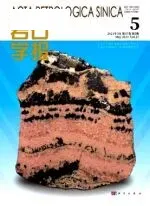喜马拉雅造山带核部的变质作用与部分熔融:亚东地区高压泥质麻粒岩的岩石学与年代学研究*
2015-07-21李旺超张泽明向华苟正彬丁慧霞
李旺超 张泽明 向华 苟正彬 丁慧霞
1.中国地质大学地球科学与资源学院,北京 100083
2.中国地质科学院地质研究所,大陆构造与动力学国家重点实验室,北京 100037
1 引言
由印度板块和欧亚板块在新生代碰撞作用形成的喜马拉雅造山带是研究大陆碰撞造山和板块构造的天然实验室(Burg et al.,1984;Hodges et al.,1992;Hodges,2000;Beaumont et al.,2001)。位于造山带核部的高喜马拉雅结晶岩系是印度板块向北俯冲于欧亚板块之下经历了高级变质和部分熔融的产物,是揭示喜马拉雅造山带形成和演化过程的关键。过去几十年,人们已经对高喜马拉雅结晶岩系进行了广泛的研究,并由此提出了多种不同的造山模型,如楔形挤出模式(Burchfiel and Royden,1985;Grujic et al.,1996;Kohn,2008)、隧道流模式(Beaumont et al.,2001,2004;Hodges et al.,2001;Godin et al.,2006)和构造楔模型(Yin,2006;Webb et al.,2007)。
目前对高喜马拉雅结晶岩系的研究主要集中在其变质作用类型与温压条件、部分熔融方式与机制、变质作用的起始和持续时间,以及变质条件和熔融程度的空间变化等(Jamieson et al.,2004;Kohn,2008;Groppo et al.,2012;Imayama et al.,2012;Wang et al.,2013;Dasgupta et al.,2004,2009;Faak et al.,2012;Rubatto et al.,2013)。喜马拉雅造山带中段的亚东地区位于造山带核部,这里很好地出露了一套高级变质岩和其深熔作用形成的淡色花岗岩,是研究喜马拉雅造山带构造演化的理想地区(图1、图2)。本文对亚东地区高喜马拉雅结晶岩系中的泥质麻粒岩进行了岩石学和锆石年代学研究,确定麻粒岩变质作用的温、压条件和P-T 轨迹、部分熔融过程、机制与时间。相关成果为进一步完善喜马拉雅造山带的形成与演化模型提供了重要信息。
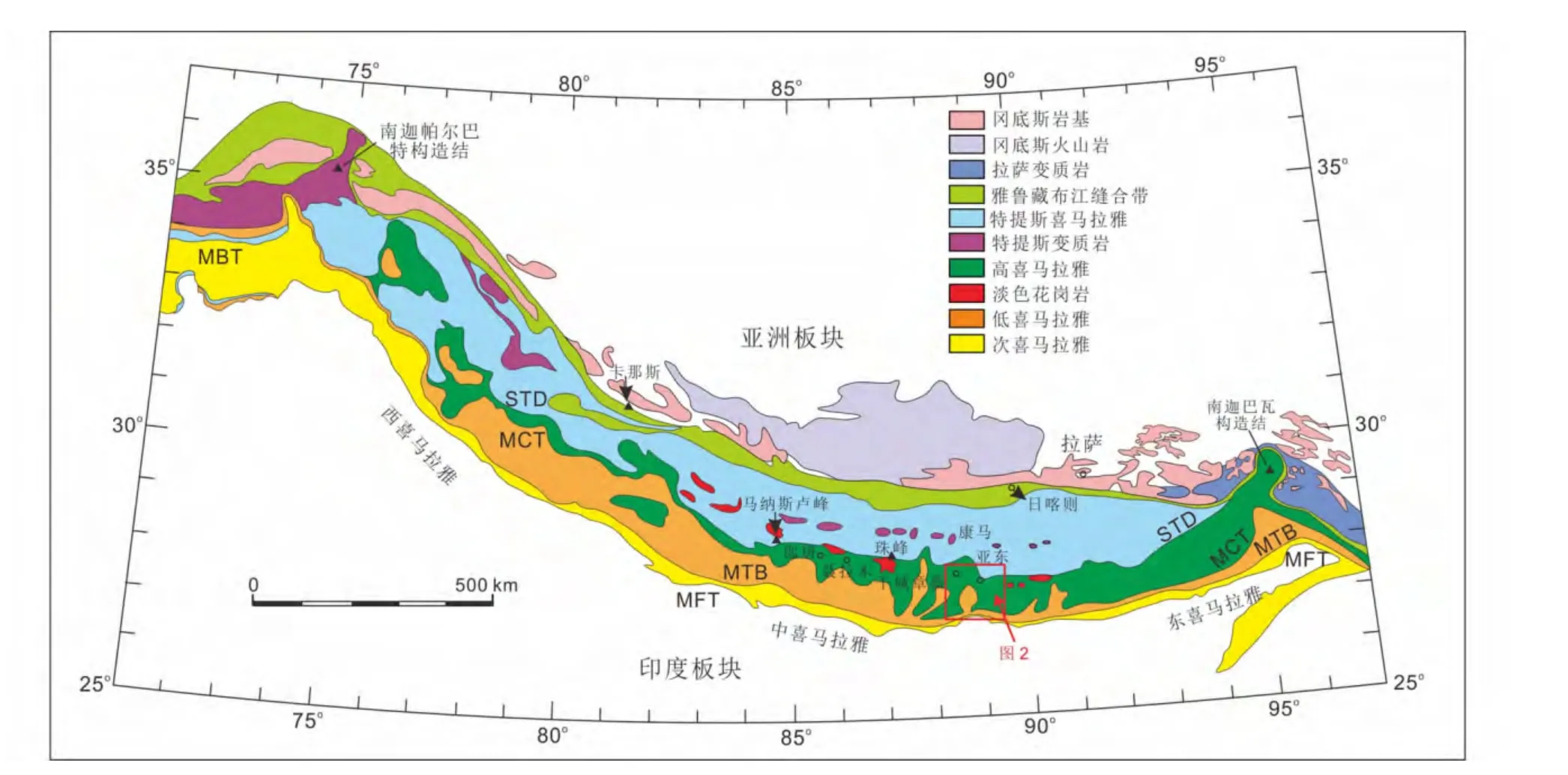
图1 喜马拉雅造山带地质简图(据Guillot et al.,2008)Fig.1 Simplified geological map of the Himalayan orogen (after Guillot et al.,2008)
2 地质背景和样品
喜马拉雅造山带由沿造山带走向分布的四个近平行的构造单元组成(图1)。从南到北它们依次为次喜马拉雅单元(前陆盆地)、低喜马拉雅岩系、高喜马拉雅结晶岩系和特提斯喜马拉雅系列。它们之间分别为主边界逆冲断裂带(MBT),主中央逆冲断裂带(MCT)和藏南拆离系(STD)(Le Fort,1975;Burg et al.,1984;Burchfiel and Royden,1985;Hodges,2000;Yin and Harrison,2000;Yin,2006)。

图2 亚东地区地质简图图中表示的矿物出现与消失等变线据Rubatto et al.(2013)Fig.2 Simplified geological map of the Yadong regionThe mineral-in and-out isograds are after Rubatto et al.(2013)
高喜马拉雅结晶岩系为角闪岩相到麻粒岩相变质的表壳岩,如泥质片岩、副片麻岩、钙硅酸盐岩和大理岩及眼球状正片麻岩组成(Kohn et al.,2001;Searle et al.,2003;Goscombe et al.,2006;Kohn,2008)。现有的研究大多认为,从低喜马拉雅岩系的上部至高喜马拉雅结晶岩系的下部发育有典型的倒转中压型变质带,即从下部构造层位向上部构造层位,变质作用程度逐渐增加,依次出现黑云母带、石榴石带、十字石带、蓝晶石带、夕线石带和堇青石带(图2;Pêcher,1989;Vannay and Grasemann,1998;Kohn et al.,2001;Searle et al.,2003;Goscombe et al.,2006;Kohn,2008;Imayama et al.,2010;Wang et al.,2013)。而且,现有的研究认为高喜马拉雅结晶岩系发生过两期区域变质作用,早期的中压型变质作用发生在38~32Ma(Vannay and Hodges,1996;Simpson et al.,2000;Godin et al.,2001),晚期的高温、中低压变质作用和广泛的深熔作用发生在26~18Ma(Simpson et al.,2000;Daniel et al.,2003)。
本文研究区位于亚东地区,构造上处于高喜马拉雅结晶岩系的上部构造层位(图2)。这里主要由眼球状正片麻岩、副片麻岩、泥质麻粒岩以及少量大理岩和钙硅酸岩组成。这些岩石多含淡色花岗岩或长英质脉体,或被淡色花岗岩墙侵入。所研究的泥质麻粒岩主要由石榴石、黑云母、夕线石、斜长石、钾长石和石英组成,含平行面理分布的长英质脉体或透镜体,表明其经历了明显的部分熔融。
3 测试方法
矿物化学成分分析是在中国地质科学院地质研究所使用JEOL JXA8900 电子探针分析。分析条件是15kV 加速电压,电子速电流为5nA,电子束斑为5μm。全岩化学成分分析是在国家地质测试中心分析。主量元素使用X 射线荧光(XRF)(rigaku-3080),分析误差<0.5%。锆石U-Pb 年龄和微量元素分析在中国地质大学(武汉)地质过程与矿产资源国家重点实验室分析,相关激光剥蚀系统和ICP-MS 仪器的详细操作方法见Liu et al.(2008,2010)。激光束斑直径为32μm,剥蚀深度为20~40μm。样品的同位素比值和元素含量数据采用ICPMS DataCal(9.1 版)软件计算,谐和图和加权平均年龄计算采用Isoplot 3(2.49 版)(Ludwig,2003)完成。
4 岩相学和矿物化学
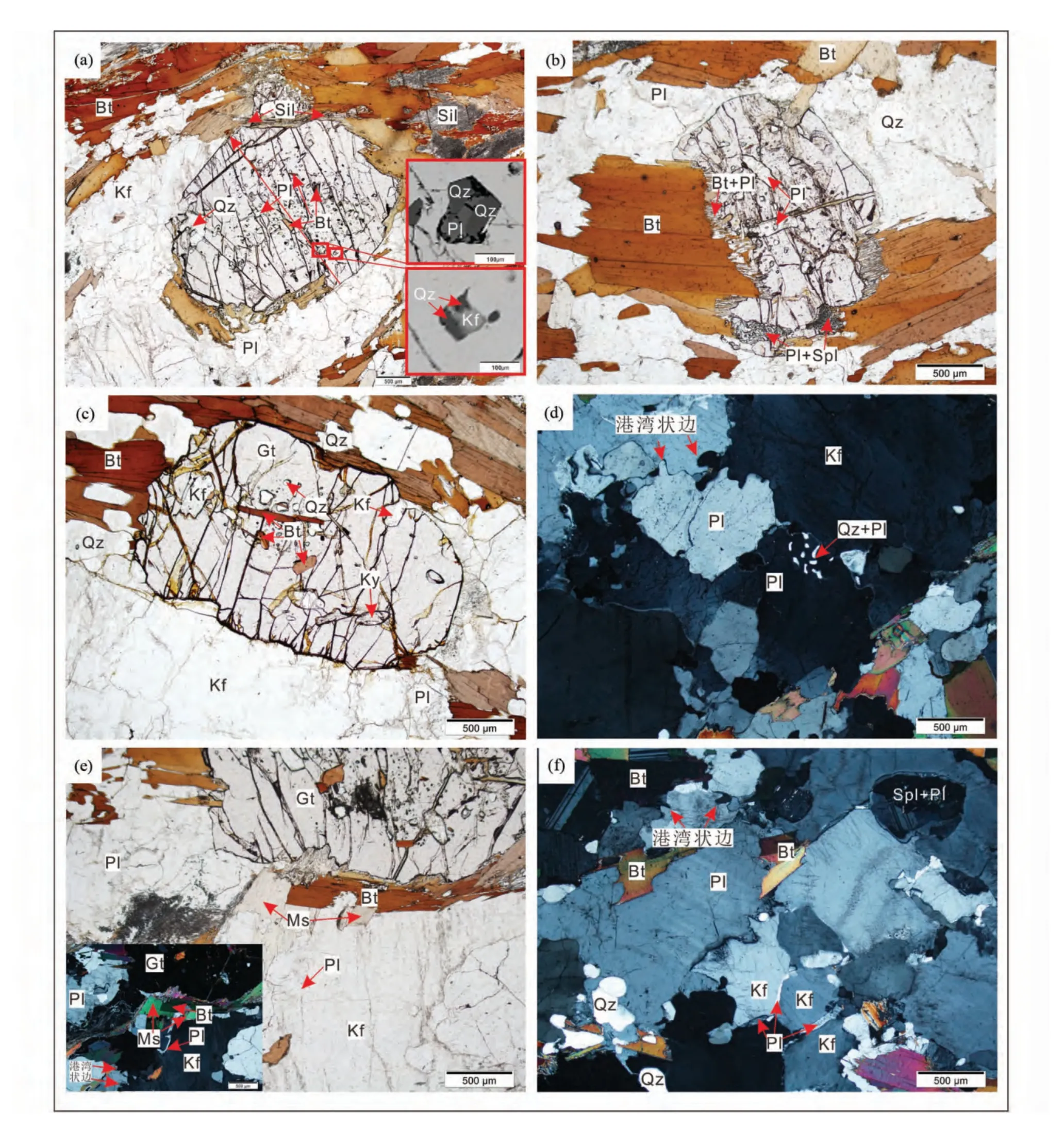
图3 亚东高压泥质麻粒岩的显微照片(a)泥质麻粒岩由石榴石、黑云母、斜长石、钾长石、石英和夕线石组成,石榴石变斑晶核部含有细小斜长石、黑云母和石英包体,石榴石幔部含有较大颗粒的斜长石、钾长石、黑云母、石英和蓝晶石包体,以及呈负晶形产出的由斜长石、钾长石和石英组成的多相矿物包体.红色实线为图4 中所示的石榴石成分剖面分析位置;(b)泥质麻粒岩中的石榴石边部被夕线石+石英+黑云母或斜长石+尖晶石合晶替代;(c)泥质麻粒岩中石榴石核部的长石、黑云母、石英包体和位于石榴石幔部的蓝晶石包体;(d)泥质麻粒岩中的大颗粒长石具港湾状边缘,部分斜长石中含蠕英状石英;(e)泥质麻粒岩中的石榴石、白云母、黑云母、斜长石、钾长石、夕线石和石英组合.此外,大颗粒矿物之间有呈薄膜状分布的斜长石;(f)充填在钾长石颗粒间的薄膜状斜长石.本文所采用矿物代号:Gt-石榴石;Bt-黑云母;Ms-白云母;Pl-斜长石;Kf-钾长石;Ky-蓝晶石;Sil-夕线石;Qz-石英;Rt-金红石;Ilm-钛铁矿;Crd-堇青石;melt-熔体;Opx-斜方辉石;Cpx-单斜辉石;Spl-尖晶石;Prp-锰铝榴石;Grs-钙铝榴石;Alm-铁铝榴石;Spe-镁铝榴石Fig.3 Photomicrographs of the HP pelitic granulite from the Yadong region
亚东地区高喜马拉雅结晶岩系中的泥质麻粒岩具有片状或条带状构造,斑状变晶结构,由石榴石、黑云母、夕线石、白云母、斜长石、钾长石和石英组成,副矿物为锆石(图3)。石榴石变斑晶为半自形粒状,其核部富含有细小的单矿物包体,如斜长石、钾长石、黑云母和石英(图3a-c),而其幔部含有较大颗粒的单矿物或多矿物包体。单矿物包体为斜长石、钾长石、黑云母、石英和蓝晶石,多相矿物包体多呈负晶形,由斜长石、钾长石和石英组成(图3a)。这些多相矿物包体代表先前的熔体包体,表明石榴石幔部是在部分熔融过程中结晶形成的转熔相(Waters,2001;Guilmette et al.,2011;Groppo et al.,2012;Rubatto et al.,2013)。石榴石的边部常被黑云母+斜长石+石英+夕线石组成的后生合晶冠状体替代(图3a,b),这样的反应被推测为退变质过程中石榴石与熔体反应的结果(Waters,2001;Cenki et al.,2002;Kriegsman and Alvarez-Valero,2009)。同时,基质中较大颗粒斜长石和钾长石的边缘多为港湾状(图3d-f),表明它们是部分熔融残余。部分斜长石含蠕虫状石英(图3d),或呈薄膜状分布于其它矿物之间(图3e,f),应为熔体结晶产物(Holness and Sawyer,2008;Sawyer,2008)。这些证据表明,泥质麻粒岩经历了部分熔融,而且至少有一部分熔体残留在岩石之中。
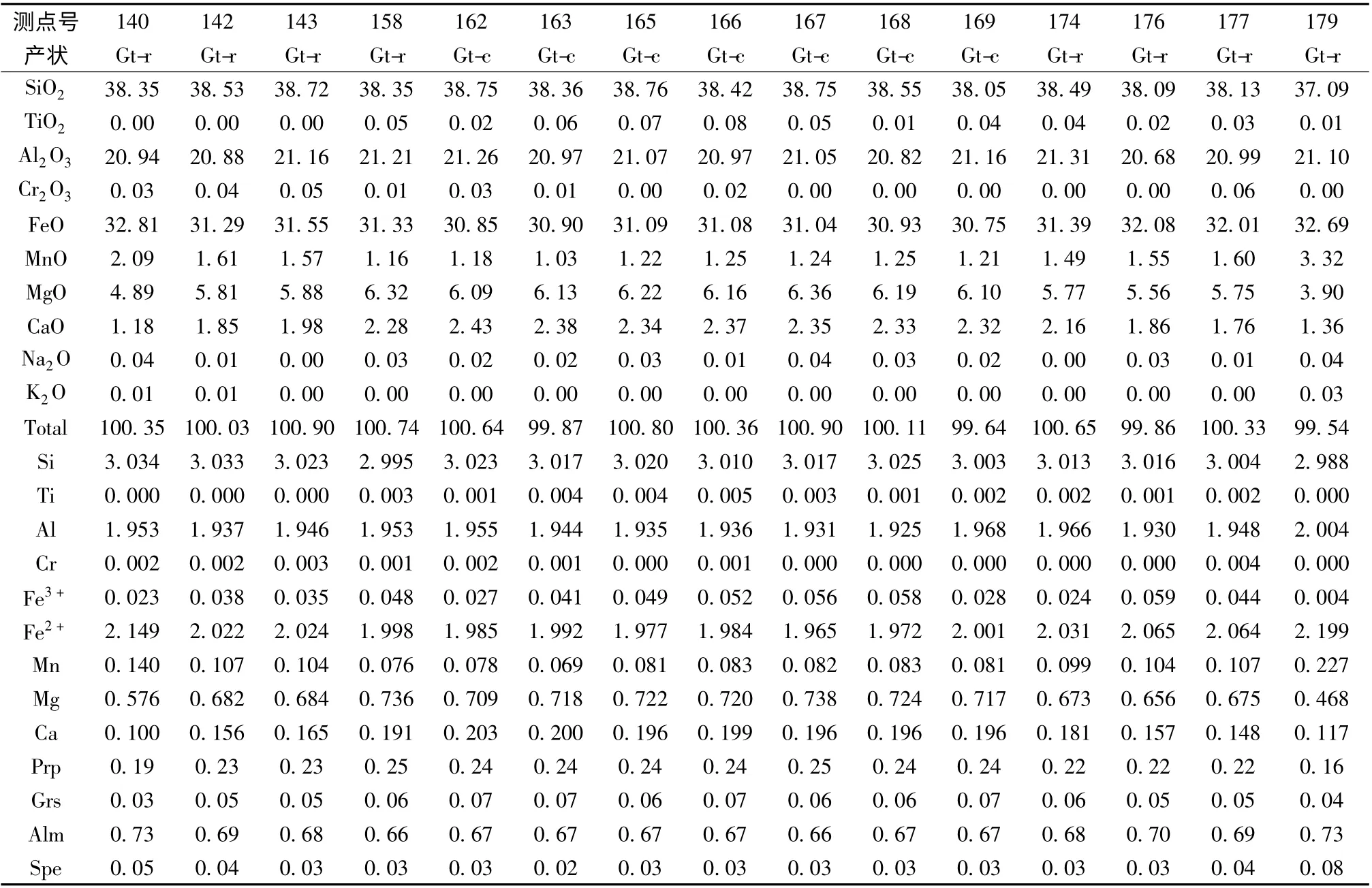
表1 高压泥质麻粒岩中代表性的石榴石电子探针分析结果(wt%)Table 1 Representative microprobe analyses of garnet of the HP pelitic granulites (wt%)
岩相学观察表明,泥质麻粒岩保存有三期变质矿物组合:早期矿物组合为石榴石核部及其所含的矿物包体,即石榴石+斜长石+钾长石+黑云母+石英;峰期矿物组合为石榴石幔部和包含的矿物包体,即石榴石+斜长石+钾长石+黑云母+蓝晶石+石英;晚期矿物组合为石榴石退变质边和基质矿物,即石榴石+斜长石+钾长石+夕线石+黑云母+白云母+石英。
探针分析结果表明,麻粒岩中的石榴石富含铁铝和镁铝榴石组分,其铁铝榴石(Alm)、镁铝榴石(Prp)、锰铝榴石(Sps)和钙铝榴石(Grs)端元组分分别为0.66~0.73、0.19~0.25、0.03~0.08 和0.03~0.07(表1)。变斑晶石榴石核部和幔部的成分较均匀,但其边缘具弱的成分环带,从内向外,铁铝榴石和锰铝榴石含量升高,镁铝榴石和钙铝榴石含量降低(图4、图5)。
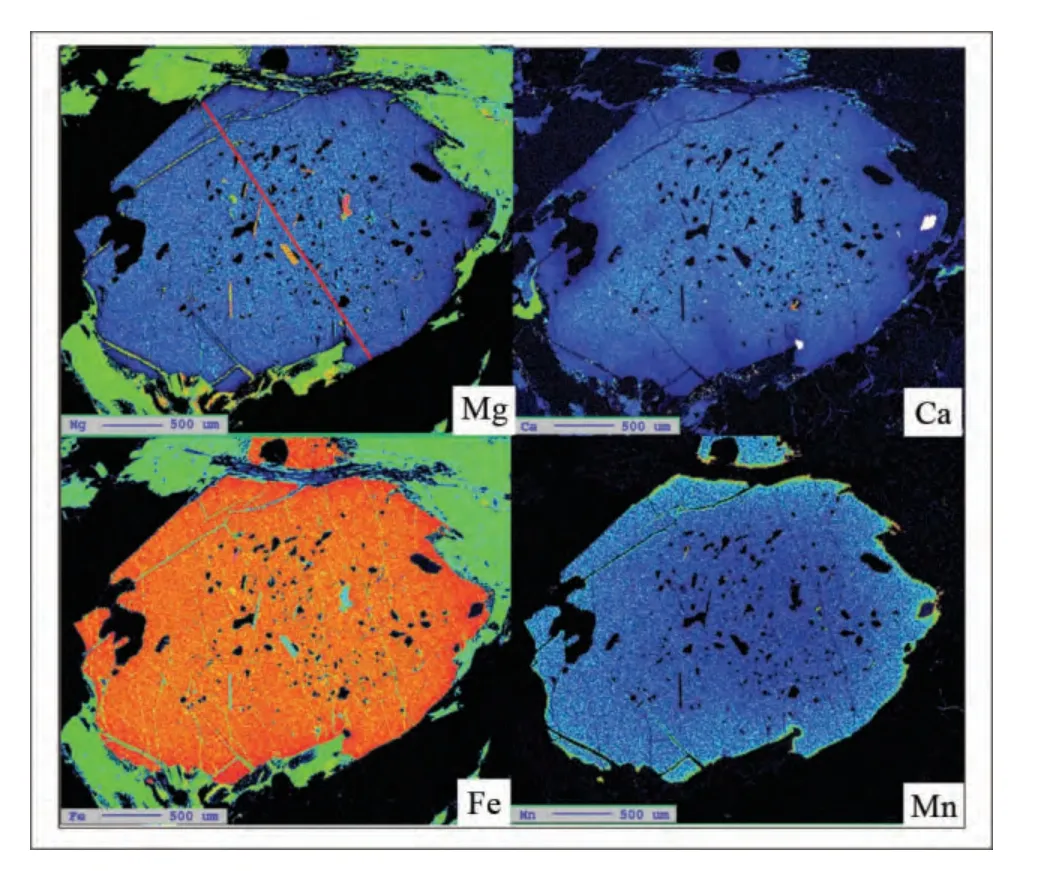
图4 高压泥质麻粒岩中石榴石变斑晶X 光成分扫描图Fig.4 X-ray mapping of the porphyroblastic garnet of the HP pelitic granulite
基质中的斜长石成分较均匀,为更长石(XAn=0.25~0.26;表2),石榴石中的包体斜长石为中长石(XAn=0.35~0.39),而在基质中呈薄膜状产出的斜长石为近纯的钠长石(XAn=0.01~0.09)。基质中的钾长石成分较均一,其XOr=0.78~0.87,石榴石包体中的钾长石为近纯的钾长石,XOr=0.95(表2)。在石榴石中呈包体的黑云母和基质中的黑云母均具有较高的TiO2(3.27%~4.9%)含量,但呈包体的黑云母具有较高的MgO(11.89%~12.11%),而基质黑云母具有较低的MgO(8.93%~9.81%)含量(表3)。此外,部分呈后生合晶产出的黑云母具有相对低的TiO2(1.55%~2.78%)和低的MgO(9.21%~9.71%)含量(表3)。
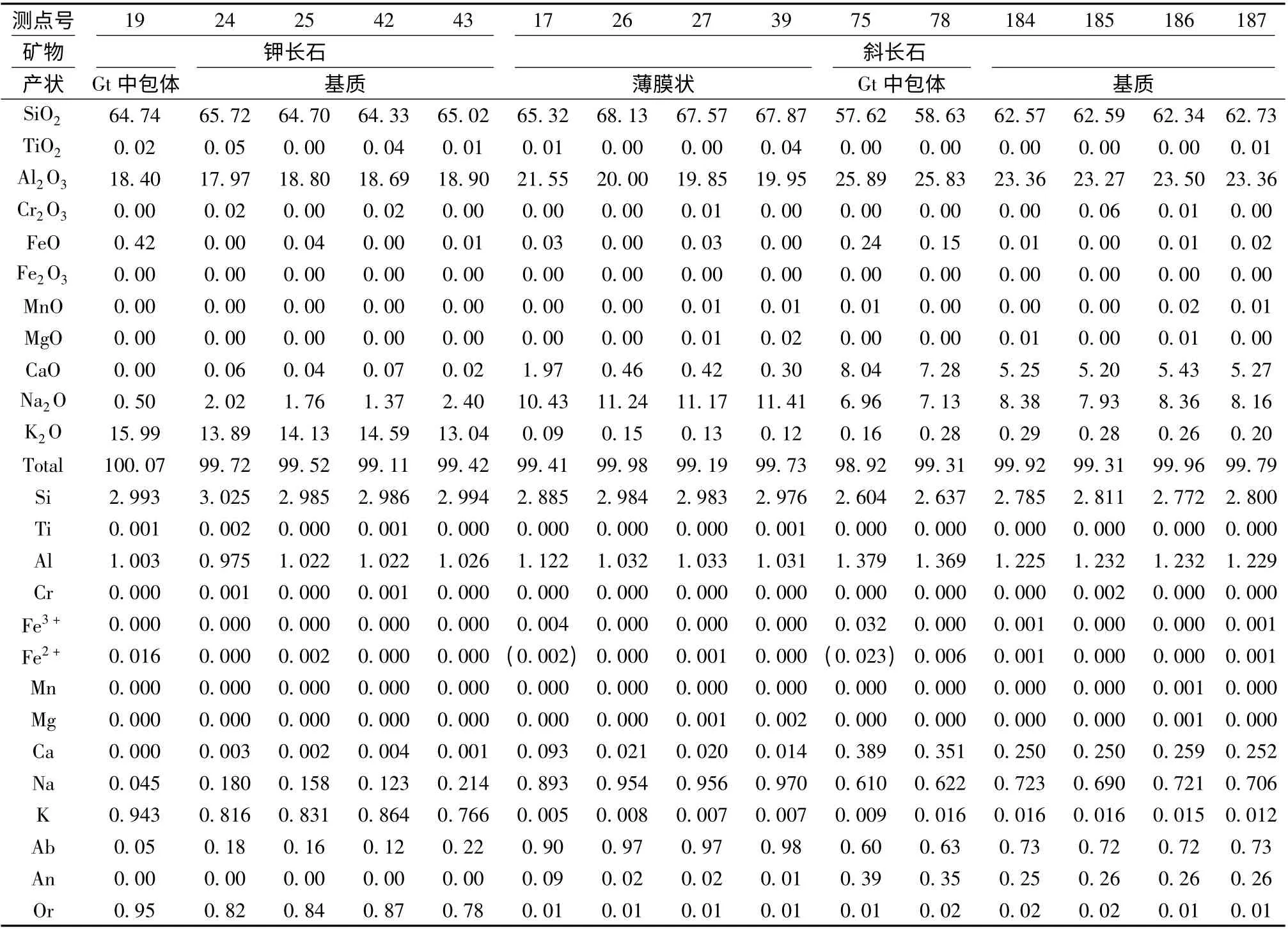
表2 高压泥质麻粒岩代表性的长石电子探针分析结果(wt%)Table 2 Representative microprobe analyses of feldspars of the HP pelitic granulites (wt%)
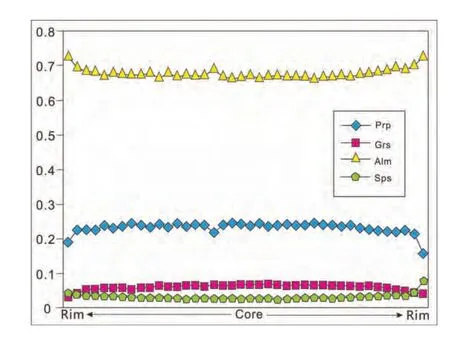
图5 高压泥质麻粒岩中石榴石成分剖面图Fig.5 Compositional profile of garnet in the HP pelitic granulite
5 相平衡模拟及变质作用P-T 条件
相平衡模拟使用Perple_X 程序(Connolly,2005,2013年升级的6.6.8 版),数据库选择Holland and Powell(1998)的升级版。所涉及的矿物及熔体相的活度-成分关系模型选自Perple_X 文件(solution_model.dat)。流体被假定为纯H2O。考虑到P2O5主要形成磷灰石,且在所研究的样品中含量很低,因此被忽略。岩石中未见有磁铁矿或其他富含Fe3+的矿物,因此假设Fe 均为Fe2+。相平衡模拟选择的成分体系为MnO-Na2O-CaO-K2O-FeO-MgO-Al2O3-SiO2-H2O-TiO2(MnNCKFMASHT)。模拟采用实测的全岩成分(SiO2=62.42%,Al2O3=17.37%,FeO=6.65%,MnO=0.15%,MgO=2.7%,CaO=1.44%,Na2O =2.47%和K2O =4.79%),水含量(1%)是基于岩石中的黑云母和白云母体积含量计算得出。计算的P-T 条件区间为5~15kbar 和600~900℃。
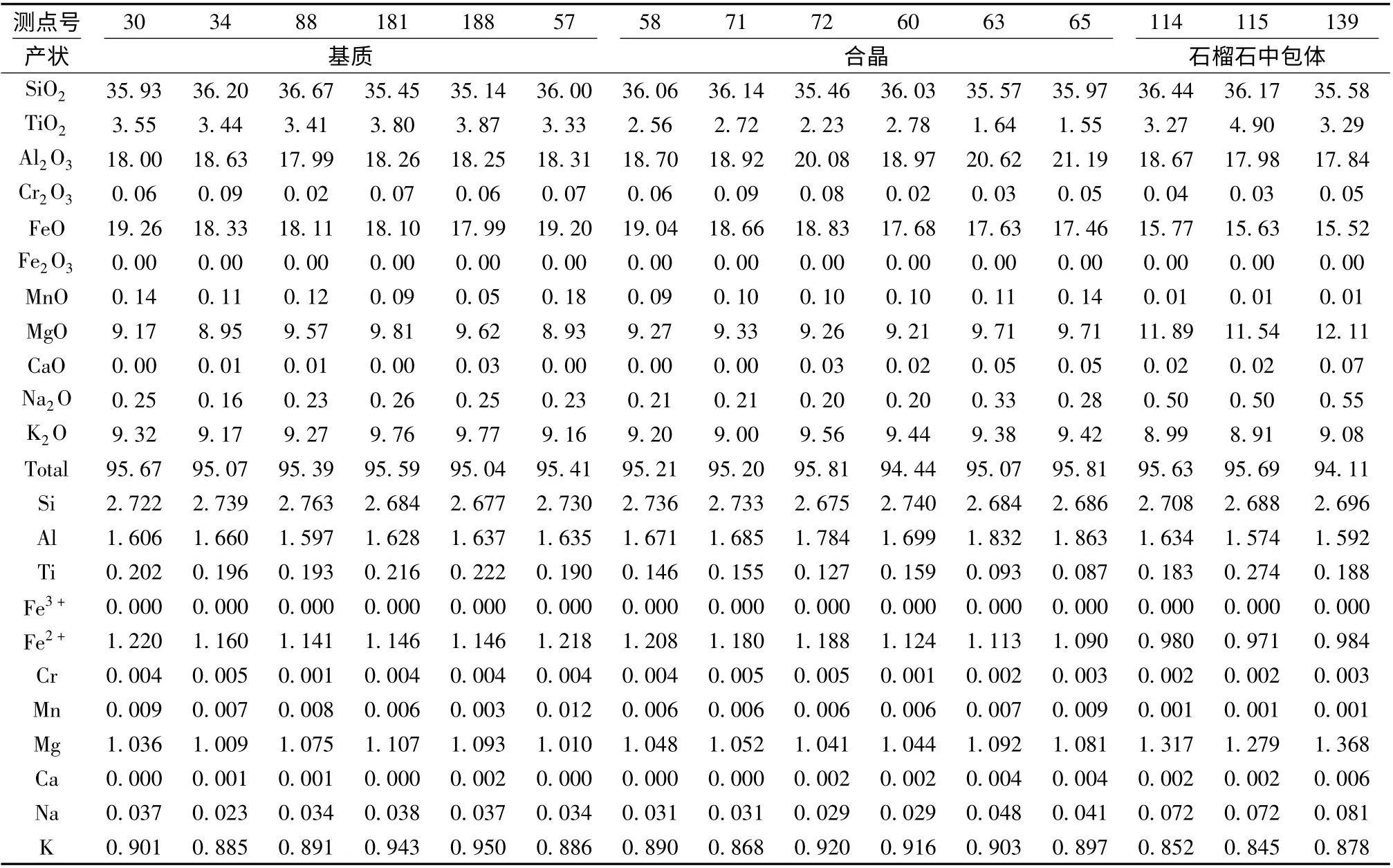
表3 高压泥质麻粒岩代表性的黑云母电子探针分析结果(wt%)Table 3 Representative microprobe analyses of biotites of the HP pelitic granulites (wt%)
从计算出的P-T 视剖面图(图6)中可以看出,石榴石稳定存在于所计算的整个P-T 区域内,蓝晶石稳定在大于5.5~12kbar 的区域,堇青石稳定在<6.8kbar 的区域,黑云母的消失温度>850℃,白云母稳定在<830℃区域。体系的固相线位于680~800℃之间,熔体含量随温度的升高而增加。
相平衡模拟表明,所观察到的峰期矿物组合Gt +Bt +Pl+Kf + Ky + Qz 稳定在有熔体存在的750~850℃和8.8~14.2kbar 区域内,其最大熔体含量为11%。退变质矿物组合Gt+Bt + Pl + Kf + Sil + Qz + Ms 稳定在600~750℃和5~8.5kbar 的区域内。相平衡模拟表明,白云母在固相线下(左侧)区域都是稳定存在的,但由于早期的白云母在进变质过程中发生脱水熔融反应而被完全消耗,使其未能在岩石中保留。所以,岩石的早期变质矿物组合应为Gt +Bt +Pl +Kf +Ms+Qz,从相平衡模拟图上可以看出,该矿物组合稳定在680~800℃和11.5~15kbar 区域内。
石榴石的成分等值线,如XPrp[=Mg/(Fe +Ca +Mg +Mn)]和XGrs[=Ca/(Fe +Ca +Mg +Mn)]值,可作为两个独立的变量来限定石榴石生长的P-T 条件(Tinkham and Ghent,2005;Garrido et al.,2006;Wei and Song,2008;Burenjargal et al.,2012)。如前所述,石榴石变斑晶具有一个成分较均匀的核部,这很可能是在高温变质条件下其成分发生均匀化的结果,而石榴石边缘的成分变化为后期退变质过程中其成分发生扩散平衡均一化的结果。因此,用石榴石核部成分得出的变质条件很可能代表该麻粒岩的最小峰期变质条件(Groppo et al.,2010,2012;Guilmette et al.,2011)。石榴石核部的XPrp为0.22~0.25,XGrs为0.05~0.07(表1),它们相交得出的温、压条件为800~835℃和12.8~14kbar(图6 中黄色实线填充圈)。所获得的温压条件范围主要位于峰期矿物组合稳定区域内,相对应的熔体含量为5%~8%(图6)。
石榴石边缘成分为后期退变质过程中扩散的结果,很可能记录了岩石的退变质条件。石榴石边缘的最低XGrs(0.03)和最低XPrp(0.16)等值线交叉给出的温压条件约为720℃和8.2kbar,非常接近退变质矿物组合的稳定区域。如果仅考虑石榴石边缘的最小XPrp值,其等值线(0.16)与退变质矿物组合稳定区交叉给出的温压条件为720~740℃和7.6~8.3kbar(图6 中绿色虚线填充圈),这可能更接近岩石的退变质条件。
相平衡模拟结果表明,所研究的变泥质岩石经历了高压麻粒岩相峰期变质作用和部分熔融,最小的峰期变质条件为800~835℃和12.8~14kbar,其最少熔体含量为5%~8%(图6)。麻粒岩的进变质条件很可能在680~800℃和11.5~15kbar 区间,而退变质条件为720~740℃和7.6~8.3kbar。联合早期进变质、峰期和退变质作用的温、压条件,可获得一个顺时针的变质作用P-T 轨迹,其进变质过程很可能为升温、升压过程,而退变质过程是以降温、降压为特征。
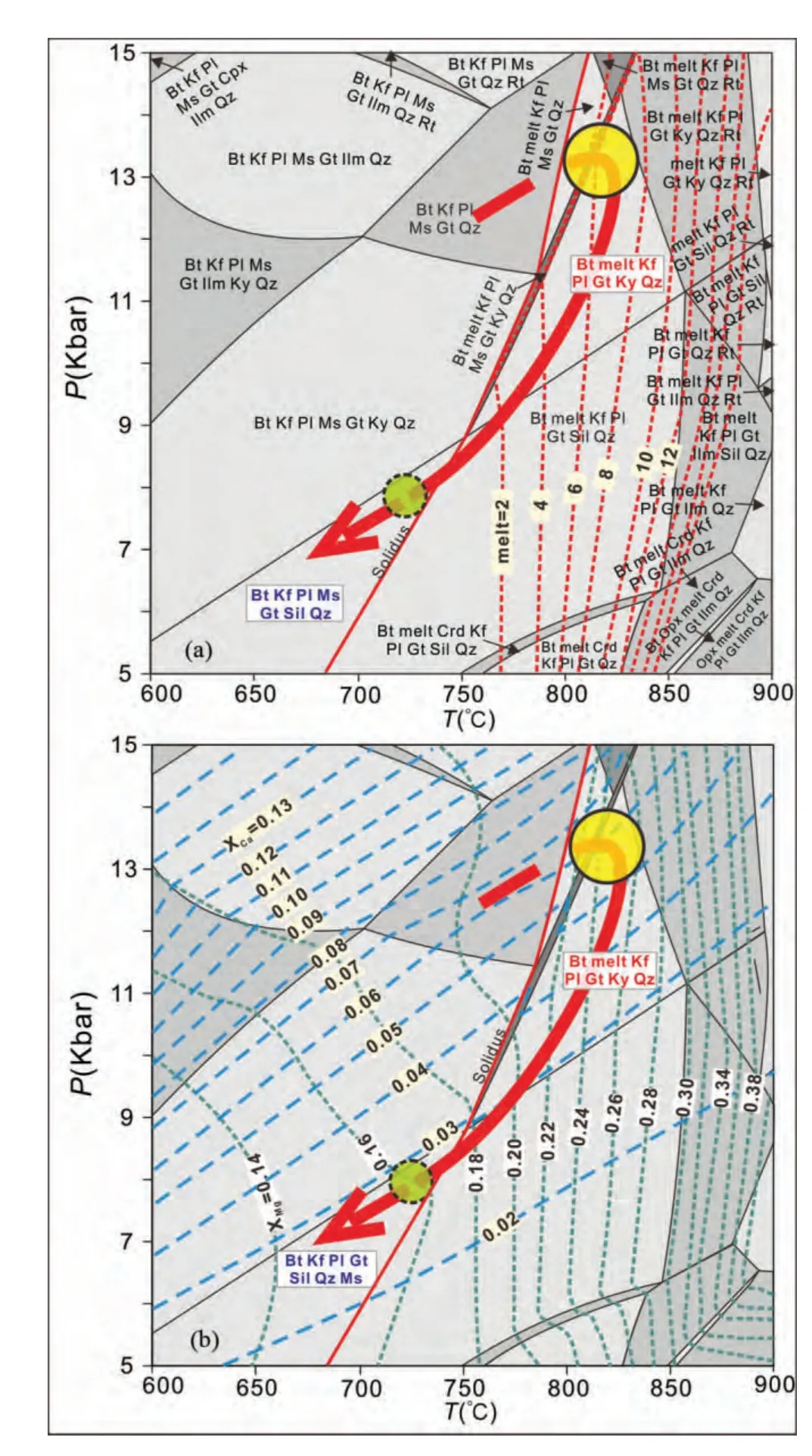
图6 高压麻粒岩的P-T 视剖面图(其中红色虚线为熔体含量等值线)(a)和石榴石成分等值线(b)绿色和蓝色虚线分别代表XCa =Ca/(Fe +Mg +Ca +Mn)和XMg =Mg/(Fe+Mg+Ca+Mn)等值线;黄色实线和绿色虚线的实心圆圈分别代表峰期变质和退变质温压条件范围Fig.6 P-T pseudosection for the high-pressure pelitic granulite (the red dashed lines refer to melt modal proportions(a)and the garnet compositional isopleths (b)The green and blue dashed lines represent isopleths of XCa =Ca/(Fe+Mg+ Ca + Mn)and XMg = Mg/(Fe + Mg + Ca + Mn)of garnet,respectively.The yellow solid line and green dotted line circles refer to the peak-metamorphic and retrograde metamorphic conditions,respectively
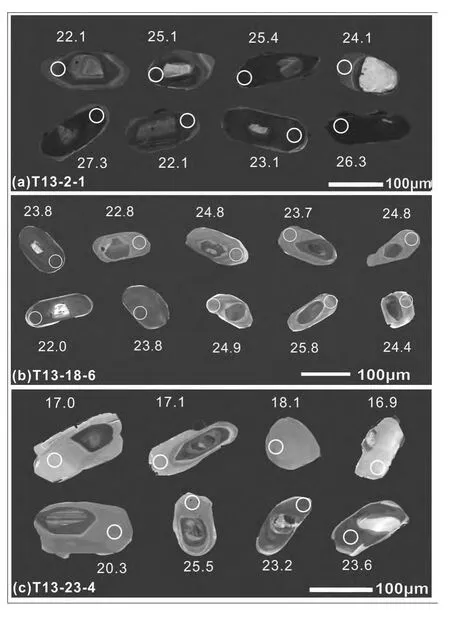
图7 高压泥质麻粒岩锆石阴极发光图像和分析点位及年龄Fig.7 Cathodoluminescence images of representative zircons of the HP pelitic granulite,showing the analytical spots and their ages
6 锆石U-Pb 定年
对3 个泥质麻粒岩中的锆石进行了LA-ICP-MS U-Pb 定年和微量元素原位分析,分析结果见表4 和表5。3 个样品中的锆石多为短柱状,粒度大小在50~120μm 之间。阴极发光图像显示,大部分锆石具有核-边结构,即由变质增生边和继承的碎屑核组成(图7)。少部分锆石呈浑圆状,无分带,为变质锆石。3 个样品中锆石的增生边和无分带锆石获得了类似的可变年龄,其206Pb/238U 年龄分别在27.4~22.1Ma、28.5~21.0Ma 和25.5~17.0Ma 之间(图8)。这些分析点都具有较低的Th/U 比值(Rubatto et al.,2013;Robert et al.,2014;Zhang et al.,2015),分别在0.008~0.019、0.015~0.048 和0.011~0.045 之间,为典型的变质锆石特征。锆石的稀土元素分异明显,以富HREE 为特征,但HREE 的配分模式大都呈平坦或亏损型,并具有负Eu 异常,仅少数锆石呈弱的HREE 富集型(图8)。这表明被定年的锆石域是与石榴石和长石同时生长的,即形成在麻粒岩相变质过程中(Corfu et al.,2003;Hoskin and Schaltegger,2003;Rubatto,2002;Rubatto and Hermann,2007)。因此,所获得的锆石年龄应代表麻粒岩的进变质至峰变质阶段的时间。
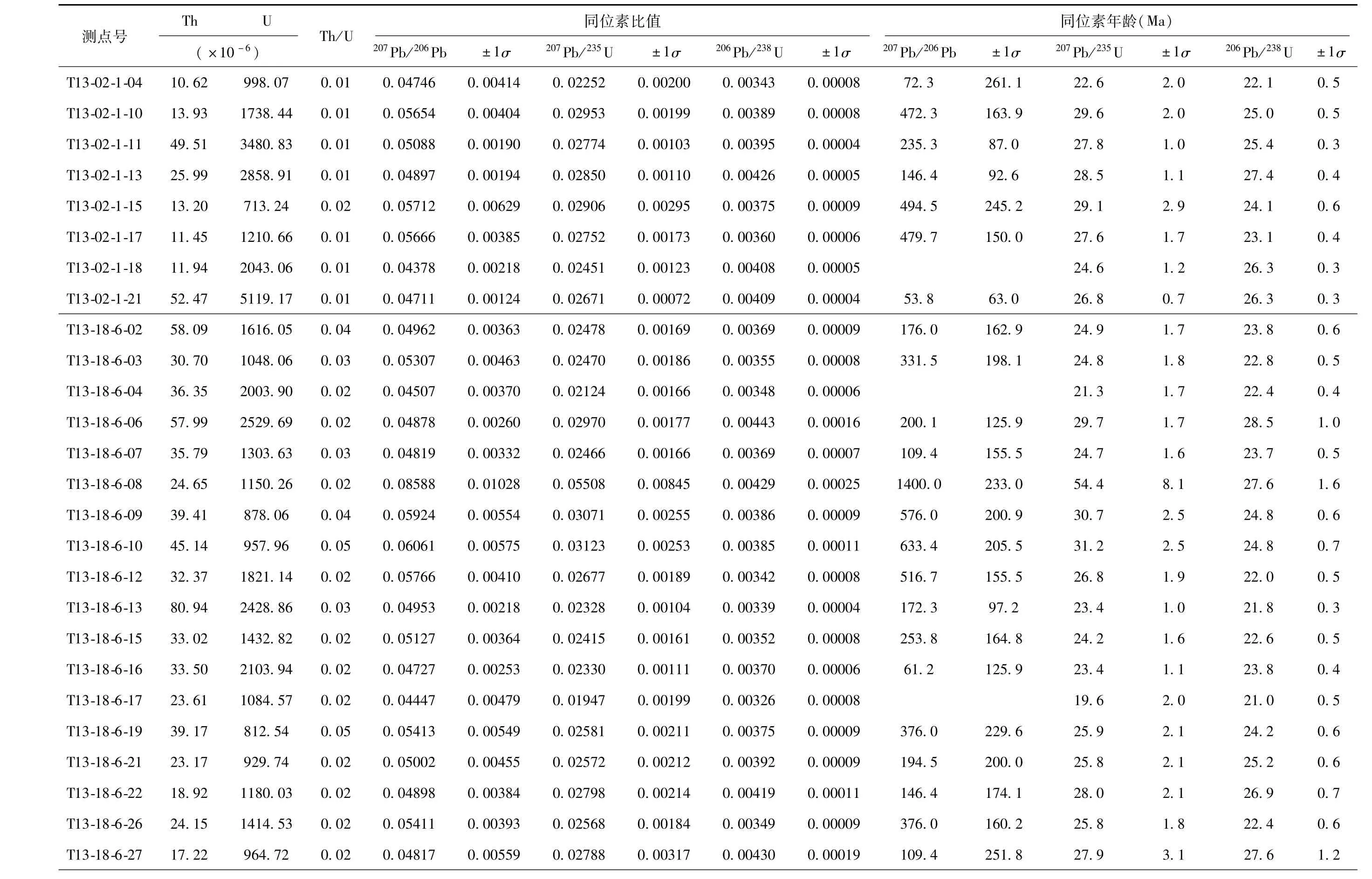
表4 高压泥质麻粒岩锆石 LA-ICP-MS U-Pb分析结果Table4 Zircon LA-ICP-MS U-Pb isotopic date of the HP pelitic granulites
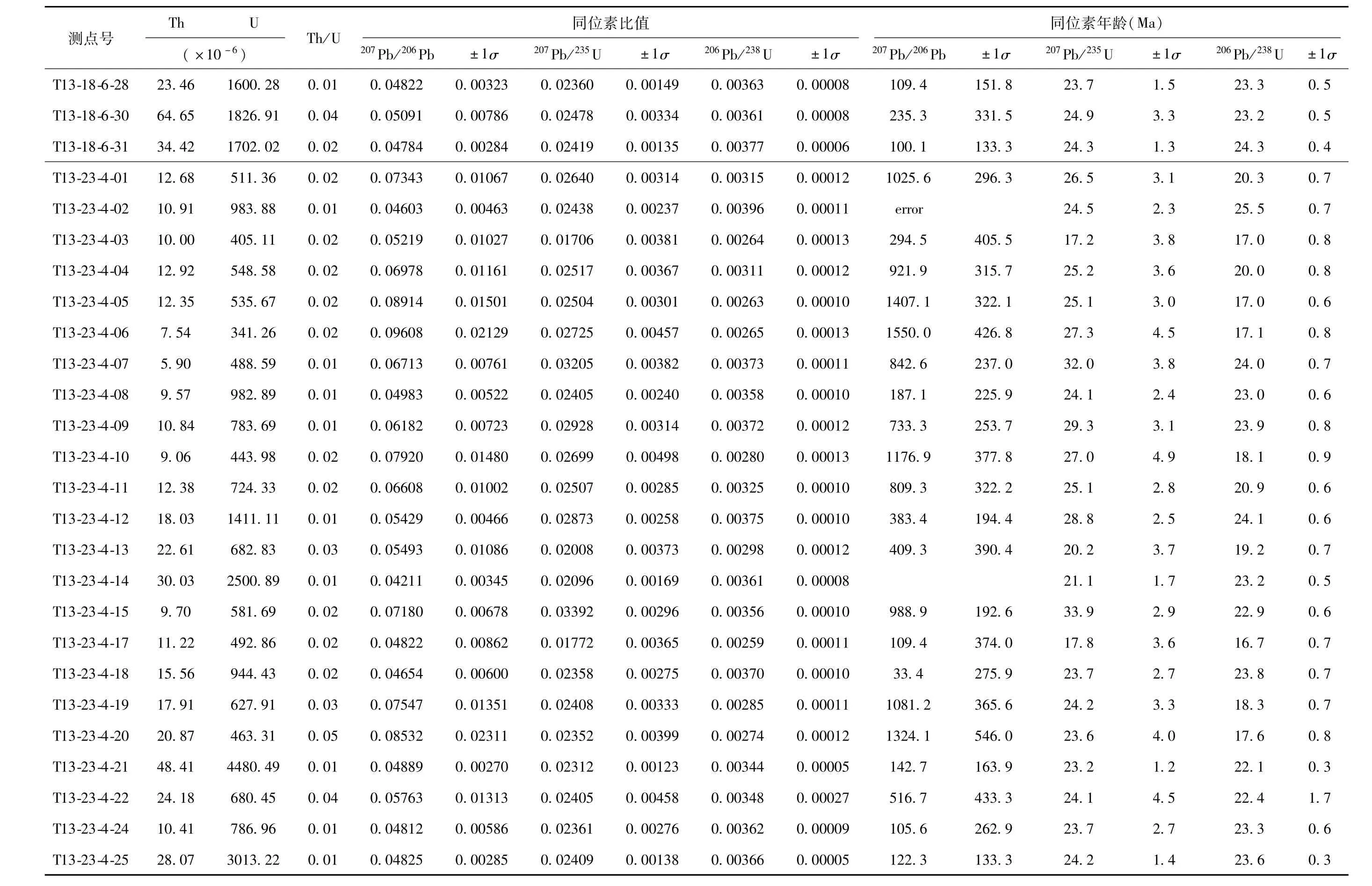
续表4Continued Table4
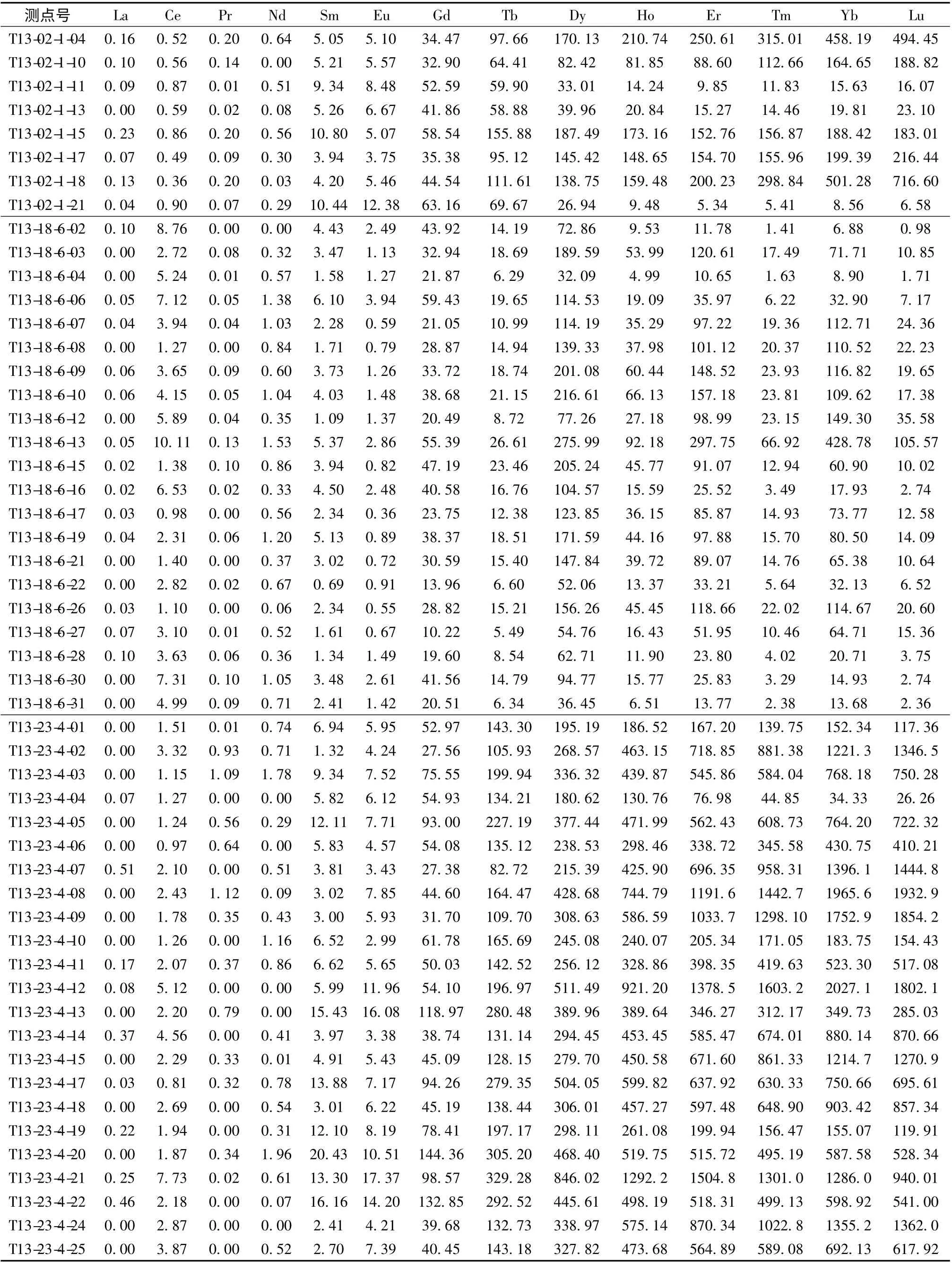
表5 高压泥质麻粒岩锆石稀土元素分析结果(×10 -6)Table 5 Zircon rare earth elements analyses of the HP pelitic granulites (×10 -6)
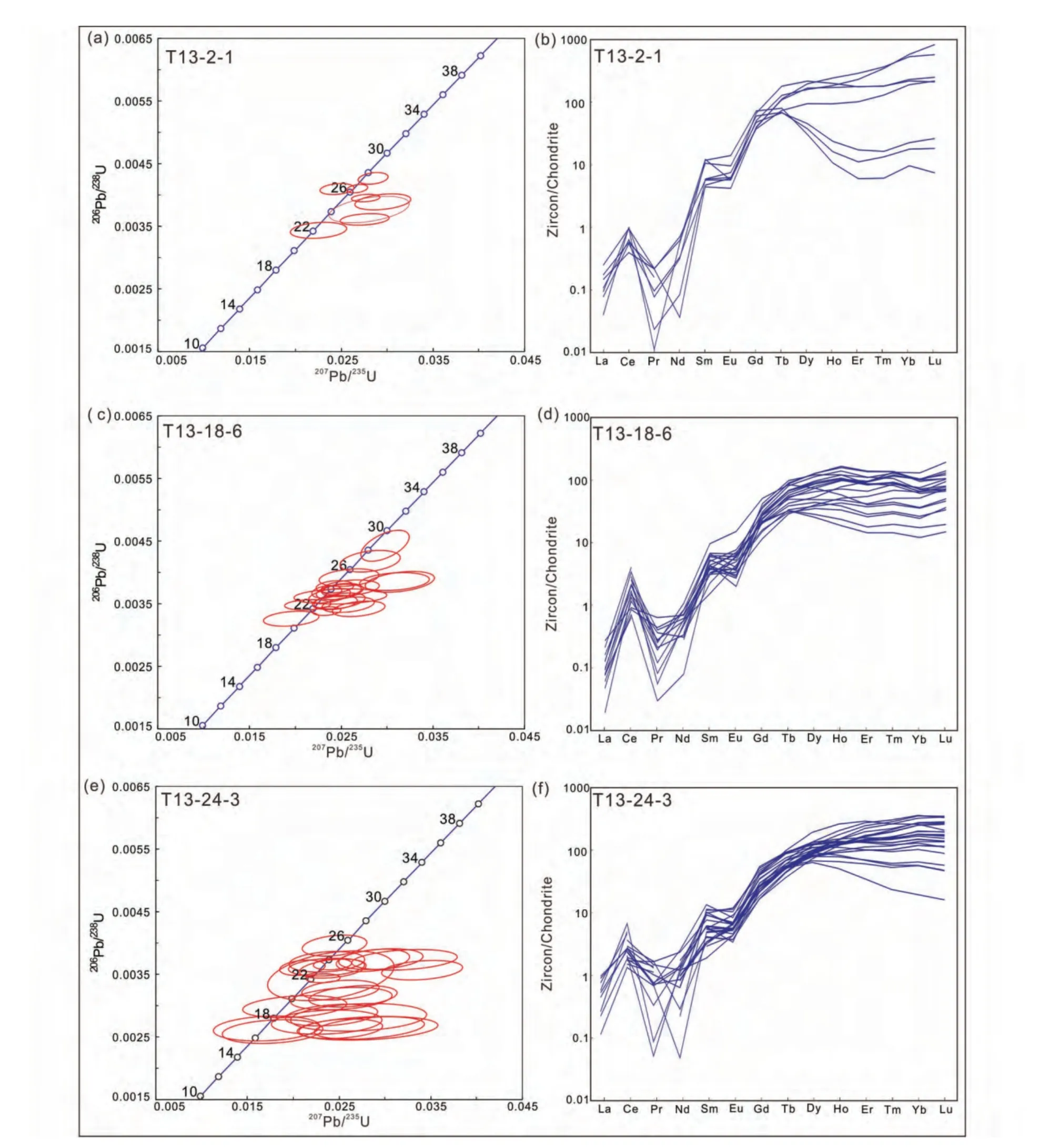
图8 亚东高压麻粒岩中锆石的U-Pb 年龄谐和图(a、c、e)和锆石稀土元素配分模式图(b、d、f)Fig.8 U-Pb concordia diagrams (a,c,e)and chondrite-normalized REE patterns (b,d,f)of zircons of the HP pelitic granulite
7 讨论
7.1 高喜马拉雅结晶岩系的变质条件
正如前面描述的,以前的研究认为,高喜马拉雅结晶岩系的下部构造层位经历了中压区域变质作用,而且发育典型的倒转型中压变质带,而高喜马拉雅结晶岩系的上部构造层位经历了中、低压和高温变质作用,相当于夕线石-钾长石带或堇青石带(图2;Pêcher,1989;Guillot et al.,1999;Fraser et al.,2000;Hodges,2000;Dasgupta et al.,2004;Searle et al.,2003)。图9 所表示的是基于岩石学研究得出的喜马拉雅造山带变质作用温、压条件的南北向空间变化剖面。大多数研究者(Pêcher,1989;Guillot et al.,1999;Fraser et al.,2000;Hodges,2000;Dasgupta et al.,2004;Searle et al.,2003)认为,高喜马拉雅结晶岩系最下部构造层位的蓝晶石带具有最高的变质温压条件,而从蓝晶石带向上直到最上部构造层位的堇青石带,岩石的变质温度逐渐升高,从约600℃升高到650~800℃,但岩石的变质压力总体上逐渐降低,从8~12kbar 降低到约4~6kbar。这样的变化规律与隧道流模型预测的并不一致。隧道流模型预测,从高喜马拉雅结晶岩系的下部到上部构造层位变质温度和压力都是逐渐降低的(图9)。
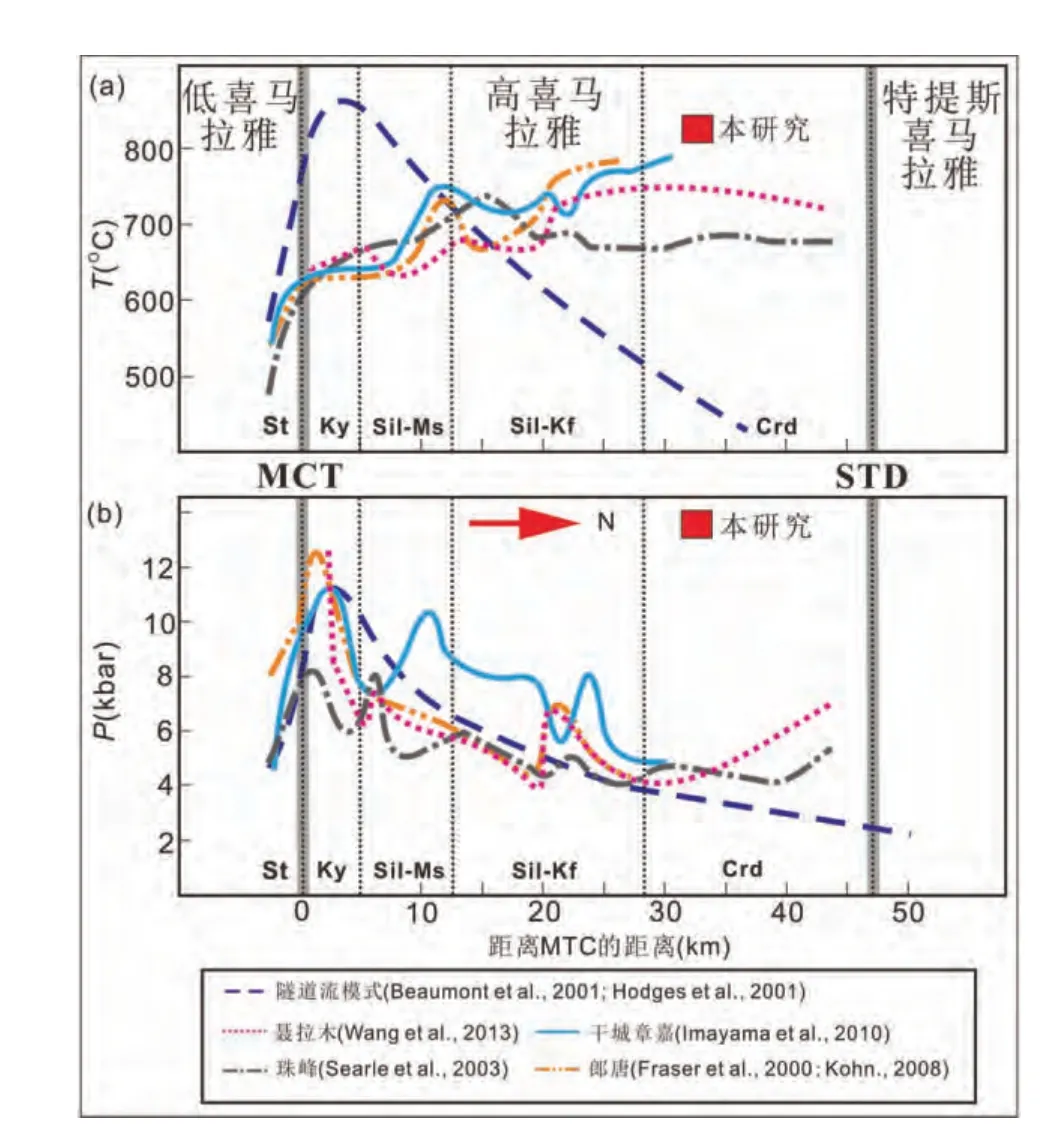
图9 高喜马拉雅结晶岩系变质作用温、压条件空间变化剖面和本文获得的变质条件从高喜马拉雅下部构造层位向上部构造层位依次为蓝晶石带、夕线石-白云母带、夕线石-钾长石带和堇青石带Fig.9 Spatial change profile of metamorphic P-T conditions of the Higher Himalayan Crystalline Sequences,showing the metamorphic conditions obtained by this studyThe kyanite, sillimanite-muscovite, sillimanite-K-feldspar and cordierite zones occur orderly from the lower to upper structural levels of the Higher Himalayan Crystalline Sequences
但是,最近的研究表明,高喜马拉雅结晶岩系的上部构造层位也经历了中、高压和高温变质作用。如有研究认为,在与亚东相邻近锡金地区,高喜马拉雅结晶岩系中的泥质麻粒岩经受了峰期为~800℃和8~9kbar 的麻粒岩相变质作用和部分熔融(Rubatto et al.,2013),或750~800℃和9~12kbar 的麻粒岩相峰期变质和部分熔融(Sorcar et al.,2014)。锡金地区高喜马拉雅结晶岩系和低喜马拉雅岩系中的基性麻粒岩经历了一致的高温(~800℃)和高压(9~12kbar)的麻粒岩相变质作用(Faak et al.,2012)。此外,最近的研究表明,尼泊尔地区高喜马拉雅结晶岩系中的泥质麻粒岩经受了峰期条件为~820℃和13kbar 的麻粒岩相变质作用(Groppo et al.,2010),变沉积岩经历了峰期可达14~16kbar 的高压麻粒岩相变质作用(Kali et al.,2010)。在喜马拉雅造山东端,高喜马拉雅结晶岩系(南迦巴瓦杂岩)中副片麻岩的峰期变质条件大于825℃和14kbar(Guilmette et al.,2011),泥质麻粒岩的峰期变质条件为840~880℃和13~16kbar(Zhang et al.,2015)。本研究进一步证明高喜马拉雅结晶岩系上部构造层位中的泥质麻粒岩经受了800~835℃和12.8~14kbar(图9 中红点位置)的高温和高压麻粒岩相变质和部分熔融。
最近的研究表明,高喜马拉雅结晶岩系的中、上部构造层位确实经历了高温、低压麻粒岩相退变质作用,其以夕线石替代蓝晶石和堇青石的出现为特征(Imayama et al.,2010;Wang et al.,2013;Rubatto et al.,2013;Sorcar et al.,2014)。先前的研究很可能将上部构造层位的退变质条件解释成了峰期变质条件,并与下部层位的峰期变质作用联系在一起,错误地建立了如图9 显示的高喜马拉雅结晶岩系P-T条件的空间变化剖面图。
7.2 高喜马拉雅结晶岩系的深熔作用
以前的研究普遍认为,高喜马拉雅结晶岩系的深熔作用发生在近等温、降压过程中(Harris et al.,2004;Harrison et al.,1997;Patiño Douce and Harris,1998;Viskupic et al.,2005;Zhang et al.,2004;Spear et al.,1984,1999)。然而,最近的研究表明,高喜马拉雅结晶岩系的部分熔融主要发生在进变质过程中,即在升温、升压过程中白云母和黑云母发生了脱水熔融(Groppo et al.,2010,2012;Guilmette et al.,2011;Zhang et al.,2015)。我们的相平衡模拟显示,泥质麻粒岩的部分熔融发生在进变质和峰期阶段(图6a),这和东喜马拉雅构造结南迦巴瓦杂岩体的部分熔融方式一致(向华等,2013)。在进变质过程中主要是白云母脱水熔融(Ms +Pl+Qz=Ky+Kf+melt),在峰期变质阶段主要是黑云母脱水熔融(Bt+Qz=Gt+Sil+Kf +melt),所形成的熔融体积至少为5%~8%。相反,在麻粒岩的降温、降压退变质过程中熔体含量将逐渐减少,直至P-T 轨迹与固相线相交时,熔体全部结晶(图6)。即使是高压麻粒岩经历了近等温降压退变质过程,其P-T 轨迹也将与熔体等容线近平行,不可能发生明显熔融(图6a)。
7.3 高喜马拉雅结晶岩系的变质和深熔作用的时间
尽管对高喜马拉雅结晶岩系进行了大量的年代学研究,但这些岩石变质和部分熔融的起始和持续时间仍然存在许多争议。现有的研究表明,高喜马拉雅结晶岩系的锆石UPb 定年结果常常是分散的,如32~17Ma(Searle et al.,2003)、33~13Ma(Cottle,2009b,2009a;Kali et al.,2010)、37~20Ma(Kohn and Corrie,2011)、33~18Ma(Imayama et al.,2012)、25~9Ma(Guo and Wilson,2012)、40~14Ma(Wang et al.,2013)、36~17Ma(Rubatto et al.,2013)、26~28Ma(Robert et al.,2014)和43~7Ma(Zhang et al.,2015)。本文和现有的研究均表明,高压泥质麻粒岩中的锆石大多具有核-边结构,变质增生边都有较低的Th/U 比值,呈平坦或亏损的HREE 模型,并具有明显的负Eu 异常(Zhang et al.,2010,2015;Rubatto et al.,2013),为麻粒岩相变质和部分熔融作用中形成锆石的典型特征(Corfu et al.,2003;Hoskin and Schaltegger,2003;Rubatto,2002;Rubatto and Hermann,2007)。Rubatto et al.(2013)认为高喜马拉雅结晶岩系泥质麻粒岩的锆石在部分熔融发生前的进变质作用过程中,以及在熔体结晶后的退变质过程中都不可能生长。他们还认为,如果岩石长期处在高温和有熔体存在的条件下,锆石很容易发生溶解和生长,由此导致锆石具有分散的年龄。因此,我们推测,本文所获得的分散锆石年龄很可能代表麻粒岩进变质和部分熔融的持续时间,因为所分析的锆石域几乎都表现出与石榴石同时生长的成分特征,而石榴石是形成在部分熔融过程中的转熔相。
本文所获得的28.5~17.0Ma 的高温麻粒岩相变质和深熔时间与Rubatto et al.(2013)在锡金泥质麻粒岩中获得的31~17Ma 的高温变质和深熔年龄是一致的,与Regis et al.(2014)在邻近不丹地区的高喜马拉雅结晶岩系中获得的36~18Ma 的高温变质年龄也是一致的。此外,Stübner et al.(2014)对喜马拉雅造山带西北部的高喜马拉雅结晶岩系的研究表明,其高温变质作用开始于约30Ma,持续到了约23Ma。Finch et al.(2014)也发现,喜马拉雅造山带西北部的高喜马拉雅结晶岩系的高温和部分熔融作用发生在29~20Ma。Zhang et al.(2015)对东喜马拉雅构造结的研究也表明,高喜马拉雅结晶岩系的高压麻粒岩相变质作用开始于约40Ma,持续到约8Ma。因此,本文和现有研究均表明,高喜马拉雅结晶岩系经历了长期持续的高温麻粒岩相变质与部分熔融过程。
8 结论
在喜马拉雅造山带中段亚东地区,高喜马拉雅结晶岩系中的泥质麻粒岩经历了高温、高压麻粒岩相变质作用和部分熔融,其峰期相矿物组合为石榴石+蓝晶石+斜长石+钾长石+黑云母+石英,峰期变质条件为800~835℃和12.8~14kbar,其变质作用P-T 轨迹为顺时针型,以增温、埋藏进变质和降温、减压退变质为特征。在进变质以及峰期变质过程中,白云母和黑云母脱水熔融导致了泥质麻粒岩发生了深熔作用,所形成的熔体体积至少为5%~8%。高温麻粒岩相变质和深熔作用发生在28.5~17.0Ma。本文研究表明,高喜马拉雅结晶岩系的上部构造层位经历了高压麻粒岩相变质作用,而不是以前认为的以高温、低压变质作用为特征。这一成果为进一步揭示高喜马拉雅结晶岩系的构造演化提供了重要信息。
致谢 感谢张聪和田作林老师对本文提出的宝贵修改意见;感谢董昕、贺振宇和祁敏老师在工作中的指导与帮助!
Beaumont C,Jamieson RA,Nguyen MH and Lee B.2001.Himalayan tectonics explained by extrusion of a low-viscosity crustal channel coupled to focused surface denudation.Nature,414(6865):738-742
Beaumont C,Jamieson RA,Nguyen MH and Medvedev S.2004.Crustal channel flows:1.numerical models with applications to the tectonics of the Himalayan-Tibetan orogen.Journal of Geophysical Research,109:B06406,doi:10.1029/2003JB002809
Burg JP,Guiraud M,Chen GM and Li GC.1984.Himalayan metamorphism and deformations in the North Himalayan Belt(southern Tibet,China).Earth and Planetary Science Letters,69(2):391-400
Burchfiel BC and Royden LH.1985.North-south extension within the convergent Himalayan region.Geology,13(10):679-682
Burenjargal U,Okamoto A,Meguro Y and Tsuchiya N.2012.An exhumation pressure-temperature path and fluid activities during metamorphism in the Tseel terrane,SW Mongolia:Constraints from aluminosilicate-bearing quartz veins and garnet zonings in metapelites.Journal of Asian Earth Sciences,54-55:214-229
Cenki B,Kriegsman LM and Braun I.2002.Melt-producing and meltconsuming reactions in the Achankovil cordierite gneisses,South India.Journal of Metamorphic Geology,20(6):543-561
Connolly JAD.2005.Computation of phase equilibria by linear programming:A tool for geodynamic modeling and its application to subduction zone decarbonation.Earth and Planetary Science Letters,236(1-2):524-541
Corfu F,Hanchar JM,Hoskin PWO and Kinny P.2003.Atlas of zircon textures.Reviews in Mineralogy and Geochemistry,53(1):469-500
Cottle JM,Jessup MJ,Newell DL,Horstwood MSA,Noble SR,Parrish RR, Waters DJ and Searle MP.2009a.Geochronology of granulitized eclogite from the Ama Drime Massif:Implications for the tectonic evolution of the South Tibetan Himalaya.Tectonics,28:TC1002,doi:10.1029/2008TC002256
Cottle JM,Searle MP,Horstwood MSA and Waters DJ.2009b.Timing of midcrustal metamorphism,melting,and deformation in the Mount Everest region of Southern Tibet revealed by U (-Th )-Pb geochronology.The Journal of Geology,117(6):643-664
Daniel CG,Hollister LS,Parrish RR and Grujic D.2003.Exhumation of the Main Central Thrust from lower crustal depths,eastern Bhutan Himalaya.Journal of Metamorphic Geology,21(4):317-334
Dasgupta S,Ganguly J and Neogi S.2004.Inverted metamorphic sequence in the Sikkim Himalayas:Crystallization history,P-T gradient,and implications.Journal of Metamorphic Geology,22(5):395-412
Dasgupta S,Chakraborty S and Neogi S.2009.Petrology of an inverted Barrovian sequence of metapelites in Sikkim Himalaya,India:Constraints on the tectonic inversion.American Journal of Science,309(1):43-84
Faak K,Chakraborty S and Dasgupta S.2012.Petrology and tectonic significance of metabasite silvers in the Lesser and Higher Himalayan domains of Sikkim,India.Journal of Metamorphic Geology,30(6):599-622
Finch M,Hasalová P,Weinberg R and Fanning M.2014.Switch from thrusting to normal shearing in the Zanskar Shear Zone,NW Himalaya:Implications for channel flow.Geological Society of America Bulletin,126(7-8):892-924
Fraser G, Worley B and Sandiford M.2000.High-precision geothermobarometry across the High Himalayan metamorphic sequence, Langtang Valley, Nepal.Journal of Metamorphic Geology,18(6):665-681
Garrido CJ,Bodinier JL,Burg JP,Zeilinger G,Hussain SS,Dawood H,Chaudhry MN and Gervilla F.2006.Petrogenesis of mafic garnet granulite in the lower crust of the Kohistan Paleo-arc Complex(Northern Pakistan):Implications for intra-crustal differentiation of island arcs and generation of continental crust.Journal of Petrology,47(10):1873-1914
Godin L,Parrish RR,Brown RL and Hodges KV.2001.Crustal thickening leading to exhumation of the Himalayan metamorphic core of central Nepal:Insight from U-Pb geo-chronology and40Ar/39Ar thermochronology.Tectonics,20(5):729-747
Godin L,Grujic D,Law RD and Searle MP.2006.Channel flow,ductile extrusion and exhumation in continental collision zones: An introduction.Geological Society,London,Special Publications,268:1-23
Goscombe B,David G and Hand M.2006.Crustal architecture of the Himalayan metamorphic front in eastern Nepal.Gondwana Research,10(3-4):232-255
Grujic D,Casey M,Davidson C,Hollister LS,Kundig R,Pavlis T and Schmid S.1996.Ductile extrusion of the Higher Himalayan Crystalline in Bhutan: Evidence from quartz micro-fabrics.Tectonophysics,260(1-3):21-43
Groppo C,Rubatto D,Rolfo F and Lombardo B.2010.Early Oligocene partial melting in the Main Central Thrust Zone (Arun valley,eastern Nepal Himalaya).Lithos,118(3-4):287-301
Groppo C,Rolfo F and Indares A.2012.Partial melting in the Higher Himalayan crystallines of Eastern Nepal:The effect of decompression and implications for the‘Channel flow’model.Journal of Petrology,53(5):1057-1088
Guillot S,Cosca M,Allemand P and Le Fort P.1999.Contrasting metamorphic and geochronologic evolution along the Himalayan Belt.Geological Society of America Special Papers,328:117-128
Guillot S,Mahéo G,de Sigoyer J,Hattori KH and Pêcher A.2008.Tethyan and Indian subduction viewed from the Himalayan high-to ultrahigh-pressure metamorphic rocks.Tectonophysics,451(1-4):225-241
Guilmette C,Indares A and Hébert R.2011.High-pressure anatectic paragneisses from the Namche Barwa,Eastern Himalayan Syntaxis:Textural evidence for partial melting,phase equilibria modeling and tectonic implications.Lithos,124(1-2):66-81
Guo ZF and Wilson M.2012.The Himalayan leucogranites:Constraints on the nature of their crustal source region and geodynamic setting.Gondwana Research,22(2):360-376
Harris NBW,Caddick M,Kosler J,Goswami S,Vance D and Tindle AG.2004.The pressure-temperature-time path of migmatites from the Sikkim Himalaya.Journal of Metamorphic Geology,22(3):249-264
Harrison TM,Lovera OM and Grove M.1997.New insights into the origin of two contrasting Himalayan granite belts.Geology,25(10):899-902
Hodges KV,Parrish RR,Housh TB,Lux DR,Burchfiel BC,Royden LH and Chen Z.1992.Simultaneous Miocene and shortening in the Himalaya orogen.Science,258(5087):1466-1469
Hodges KV.2000.Tectonics of the Himalaya and southern Tibet from two perspectives.Geological Society of America Bulletin,112(3):324-350
Hodges KV,Hurtado Jr JM and Whipple KX.2001.Southward extrusion of Tibetan crust and its effect on Himalayan tectonics.Tectonics,20(6):799-809
Holland TJB and Powell R.1998.An internally consistent thermodynamic data set for phases of petrological interest.Journal of Metamorphic Geology,16(3):309-343
Holness MB and Sawyer EW.2008.On the pseudomorphing of melt-filled pores during the crystallization of migmatites.Journal of Petrology,49(7):1343-1363
Hoskin PWO and Schaltegger U.2003.The composition of zircon and igneous and metamorphic petrogenesis.Reviews in Mineralogy and Geochemistry,53(1):27-62
Imayama T,Takeshita T and Arita K.2010.Metamorphic P-T profile and P-T path discontinuity across the far-eastern Nepal Himalaya:Investigation of channel flow models.Journal of Metamorphic Geology,28(5):527-549
Imayama T,Takeshita T,Yi K et al.2012.Two-stage partial melting and contrasting cooling history within the Higher Himalayan Crystalline Sequence in the far-eastern Nepal Himalaya.Lithos,134-135:1-22
Jamieson RA,Beaumont C,Medvedev S and Nguyen MH.2004.Crustal channel flows: 2.Numerical models with implications for metamorphism in the Himalayan-Tibetan orogen.Journal of Geophysical Research,109:B06407,doi:10.1029/2003JB002811
Kali E,Leloup PH,Arnaud N,Maheo G,Liu DY,Boutonnet E,Van der Woerd J,Liu XH,Liu ZJ and Li HB.2010.Exhumation history of the deepest central Himalayan rocks,Ama Drime range:Key pressure-temperature-deformation-time constraints on orogenic models.Tectonics,29(2):1-31
Kohn MJ,Catlos EJ,Ryerson FJ and Harrison TM.2001.Pressuretemperature-time path discontinuity in the Main Central thrust zone,central Nepal.Geology,29(3):571-574
Kohn MJ.2008.P-T-t data from central Nepal support critical taper and repudiate large-scale channel flow of the Greater Himalayan sequence.Geological Society of America Bulletin,120(3-4):259-273
Kohn MJ and Corrie SL.2011.Preserved Zr-temperature and U-Pb ages in high-grade metamorphic titanite:Evidence for a static hot channel in the Himalayan orogen.Earth and Planetary Science Letters,311(1-2):136-143
Kriegsman LE and álvarez-Valero AM.2009.Melt-producing versus meltconsuming reactions in pelitic xenoliths and migmatites.Lithos,116(3-4):310-320
Le Fort P.1975.Himalayas:The collided range.Present knowledge of the continental arc.American Journal of Science,275:1-44
Liu YS,Hu ZC,Gao S,Gunther D,Xu J,Gao CG and Chen HH.2008.In situ-analysis of major and trace elements of anhydrous minerals by LA-ICP-MS without applying an internal standard.Chemical Geology,257(1-2):34-43
Liu YS,Gao S,Hu ZC,Gao CG,Zong KQ and Wang DB.2010.Continental and oceanic crust recycling-induced melt-peridotite interactions in the Trans-North China Orogen:U-Pb dating,Hf isotopes and trace elements in zircons of mantle xenoliths.Journal of Petrology,51(1-2):537-571
Ludwig KR.2003.ISOPLOT 3.00:A Geochronological Toolkit for Microsoft Excel.Berkeley:Berkeley Geochronology Center
Patiño Douce AE and Harris N.1998.Experimental constraints on Himalayan anatexis.Journal of Petrology,39(4):689-710
Pêcher A.1989.The metamorphism in the Central Himalaya.Journal of Metamorphic Geology,7(1):31-41
Regis D,Warren CJ,Young D and Roberts NMW.2014.Tectonometamorphic evolution of the Jomolhari massif:Variations in timing of syn-collisional metamorphism across western Bhutan.Lithos,190-191:449-466
Robert A,Sumit C,Somnath D,Dilip M and Katarzyna K.2014.Timing,duration and inversion of prograde Barrovian metamorphism constrained by high resolution Lu-Hf garnet dating:A case study from the Sikkim Himalaya,NE India.Earth and Planetary Science Letters,407:70-81
Rubatto D.2002.Zircon trace element geochemistry:Partitioning with garnet and the link between U-Pb ages and metamorphism.Chemical Geology,184(1-2):123-138
Rubatto D and Hermann J.2007.Zircon behaviour in deeply subducted rocks.Elements,3(1):31-35
Rubatto D,Chakraborty S and Dasgupa S.2013.Timescales of crustal melting in the Higher Himalayan Crystallines (Sikkim,Eastern Himalaya)inferred from trace element-constrained monazite and zircon chronology.Contributions to Mineralogy and Petrology,165(2):349-372
Sawyer EW.2008.Atlas of Migmatites.The Canadian Mineralogist,Special Publication 9.Ottawa, Ontario, Canada: NRC Research Press
Searle MP,Simpson RL and Law RD.2003.The structural geometry,metamorphic and magmatic evolution of the Everest massif,High Himalaya of Nepal-South Tibet.Journal of the Geological Society,160(3):345-366
Simpson RL,Parrish RR,Searle MP and Waters DJ.2000.Two episodes of monazite crystallization during metamorphism and crustal melting in the Everest region of the Nepalese Himalaya.Geology,28(5):403-406
Sorcar N,Hoppe U,Dasgupta S and Chakraborty S.2014.Hightemperature cooling histories of migmatites from the High Himalayan Crystallines in Sikkim, India: Rapid cooling unrelated to exhumation.Contributions to Mineralogy and Petrology,167(2):1-34
Spear FS,Selverstone J,Hickmott D,Crowley P and Hodges KV.1984.P-T paths from garnet zoning:A new technique for deciphering tectonic processes in crystalline terranes.Geology,12(2):87-90
Spear FS,Kohn MJ and Cheney JT.1999.P-T paths from anatectic pelites.Contributions to Mineralogy and Petrology,134(1):17-32
Stübner K,Grujic D,Parrish RR,Roberts NMW,Kronz A,Wooden J and Ah mad T.2014.Monazite geochronology unravels the timing of crustal thickening in NW Himalaya.Lithos,210-211:111-128
Tinkham DK and Ghent ED.2005.Estimating P-T conditions of garnet growth with isochemical phase diagram sections and the problem of effective bulk composition.Canadian Mineralogist,43(1):35-50
Vannay JC and Hodges KV.1996.Tectonometamorphic evolution of the Himalayan metamorphic core between the Annapurna and Dhaulagiri,central Nepal.Journal of Metamorphic Geology,14(5):635-656
Vannay JC and Grasemann B.1998.Inverted metamorphism in the High Himalaya of Himachal Pradesh (NW India):Phase equilibria versus thermobarometry.Schweizerische Mineralogissche and Petrographische Mitteilungen,78:107-132
Viskupic K,Hodges KV and Bowring SA.2005.Timescales of melt generation and the thermal evolution of the Himalayan metamorphic core,Everest region,eastern Nepal.Contributions to Mineralogy and Petrology,149(1):1-21
Wang JM,Zhang JJ and Wang XX.2013.Structural kinematics,metamorphic P-T profiles and zircon geochronology across the Greater Himalayan Crystalline Complex in south-central Tibet:Implication for a revised channel flow.Journal of Metamorphic Geology,31(6):607-628
Waters DJ.2001.The significance of prograde and retrograde quartzbearing intergrowth microstructures in partially melted granulite facies rocks.Lithos,56(1):97-110
Webb AAG,Yin A,Harrison TM,Célérier J and Burgess WP.2007.The leading edge of the Greater Himalayan Crystallines revealed in the NW Indian Himalaya:Implications for the evolution of the Himalayan Orogen.Geology,35(10):955-958
Wei CJ and Song SG.2008.Chloritoid-glaucophane schist in the North Qilian orogen,NW China:Phase equilibria and P-T path from garnet zonation.Journal of Metamorphic Geology,26(3):301-316
Xiang H,Zhang ZM,Dong X,Qi M,Lin YH and Lei HC.2013.Highpressure metamorphism and anatexis during the subduction of Indian continent:Phase equilibria modeling of the Namche Barwa complex,Eastern Himalayan Syntaxis.Acta Petrologica Sinica,29(11):3792-3802 (in Chinese with English abstract)
Yin A and Harrison TM.2000.Geologic evolution of the Himalayan-Tibetan orogen.Annual Review of Earth and Planetary Sciences,28:211-280
Yin A.2006.Cenozoic tectonic evolution of the Himalayan orogen as constrained by along-strike variation of structural geometry,exhumation history, and foreland sedimentation.Earth-Science Reviews,76(1-2):1-131
Zhang JJ,Ji JQ,Zhong DL,Ding L and He SD.2004.Structural pattern of eastern Himalayan syntaxis in Namjagbarwa and its formation process.Science in China (Series D),47(2):138-150
Zhang ZM,Zhao GC,Wang JL,Dong X and Liou JG.2010.Two stages of granulite facies metamorphism in the eastern Himalayan syntaxis,south Tibet:Petrology,zircon geochronology and implications for the subduction of neo-Tethys and the Indian continent beneath Asia.Journal of Metamorphic Geology,28(7):719-733
Zhang ZM,Xiang H,Dong X,Ding HX and He ZY.2015.Long-lived high-temperature granulite-facies metamorphism in the Eastern Himalayan orogen,South Tibet.Lithos,212-215:1-15
附中文参考文献
向华,张泽明,董昕,祁敏,林彦蒿,雷恒聪.2013.印度大陆俯冲过程中的高压变质与深熔作用:东喜马拉雅构造结南迦巴瓦杂岩的相平衡模拟研究.岩石学报,29(11):3792-3802
